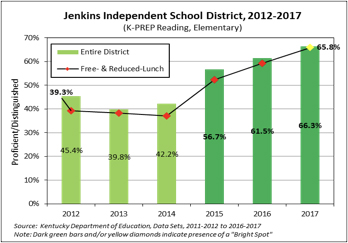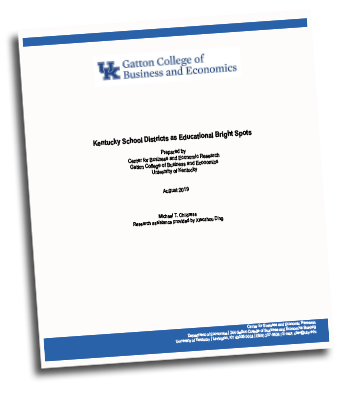FEBRUARY 2020 \\ JENKINS INDEPENDENT
“Y. Yellow. yuh.” These are the sounds of kindergarten students building the ground floor of becoming a reader. At a horseshoe-shaped table, Vonda Penley, a kindergarten teacher at Jenkins Elementary School, reviews letters and sounds. The small group discusses vowels and consonants. They open a book and read together.
“The…dog…is…in…the…car,” reads the chorus of five- and six-year-olds. The picture book features dogs in interesting settings. On the page showing a dog on the water, one girl looks closely at the words. She asks her teacher, “Why does it say ‘at’ in boat?”
“We will talk about that,” Penley promises. “It’s a different kind of sound.”
You can see the young readers emerging.
The cycle of helping students learn to sound out words, read fluently, and recognize what is happening within different types of texts is a process repeated each year in every elementary school. In high-poverty schools like Jenkins, where the family income of 83 percent of students qualifies for free- or reduced-price meals, building proficient readers comes with deep challenges.
“We’re a work in progress,” said Superintendent Mike Genton. The school is focused on grade-level numeracy and literacy by the end of the third grade. “It’s so important to have those children where they need to be at end of third grade, because research shows that if they’re behind then, the chances of catching up go down significantly,” Genton said.
Each year’s wave of students presents new challenges and opportunities.
Jenkins was created in 1912 as a mining town, built after a railroad extended into a valley beneath a mountain ridge separating Kentucky and Virginia. Like most structures here, Jenkins Elementary is built beside Elkhorn Creek. It is a school of 200 in an independent school district comprised of 420 students.

KINDERGARTEN TEACHER Vonda Penley, left, works with a small group of students discussing the sounds that letters make in reading.
Last year, Jenkins was an under-the-radar locale that emerged as a “bright spot district” in a statewide analysis of student test scores by the Center for Business and Economic Research at the University of Kentucky.
The study, conducted in partnership with the Prichard Committee for Academic Excellence, examined scores on state tests from 2012-17. Rather than simply ranking scores, it used local socioeconomic data to establish a predicted level of performance. The report identified 12 districts that significantly exceeded those expectations based on overall average test scores in at least one of the years studied. “Exemplar” districts were also required to meet other requirements — less-advantaged students had to show steady progress over the span, including a better-than-expected outcome in 2017.
Elementary reading scores in Jenkins met the study’s definition of unexpectedly high performance. The report explained: “The Jenkins Independent School District in Letcher County and the Russell Independent School District in Greenup County performed similarly on the 2016‐17 K‐PREP elementary mathematics assessment, demonstrated by 57.3 and 58.2 percent of their students scoring proficient or distinguished, respectively. Yet, once we consider student, district, and community factors, only one of these districts emerges as a “bright spot” — Jenkins Independent. While Russell Independent performs at a level we expect, Jenkins Independent performs much better than we expect; in fact, it performs 20 percentage points higher than we expect.”
Jenkins earned the exemplar status based on its elementary reading performance. Exceeding expectations in other measures and at other school levels also made Jenkins one of the top districts in the state in the study’s cumulative points for beating predictions based on demographics.
Jenkins school leaders point to several advantages they see in their district: Its small size in a rural community promotes close connections and strong relationships; students get extra access to teachers, and the conditions of a community in economic distress underscore the importance of education in improving one’s options in life.
There are also drawbacks, of course. Resources are limited. The pool of candidates for open teaching jobs can be small. Maybe most noticeable, a single classroom defines the work of a grade level, meaning that teacher turnover can have dramatic effects on student and district performance.
District leaders say that in a very small school, teacher turnover can have dramatic effects on student and district results.
The UK report may have found Jenkins at a peak level. In recent years, retirements and moves have put the school in a rebuilding mode, much like sports teams that lose key players after a playoff run.
“One of the hardest challenges is retaining good teachers,” said Christle Carter, the district’s instructional supervisor, who is concentrating on building up reading performance at the elementary school and supporting the focus on moving students in K-3 to grade-level performance. “What’s positive is that we’re so small — we work together well, like a family,” she added.
The school is trying new ways of reaching out to families with communication and programs designed to build stronger relationships. It adopted the “Leader in Me” program to get students become more active in their own learning. The school is also adjusting its reading curriculum for a deeper emphasis on comprehension and writing. It is also pleased by the potential its two young kindergarten teachers show.
The UK report found previous periods of major gains at Jenkins Elementary. Principal Amanda Anderson is optimistic that elements are in place that will help the current improvement drive attain similar results. The school closely monitors student data to deliver extra help, she noted. Technology upgrades give students access to helpful learning programs, and the school has altered its use of extended school service funds to expand tutoring during the school day.
Anderson is also focused on building a close school community and cohesive culture among the school staff. “We’ve had a couple of periods where we were really successful, and when I look back at what we were doing, it was a group effort,” said the second-year principal, a former Jenkins teacher. “You can throw programs at people all day long — adults and kids — but if there’s not a heart involved in it, and you don’t have people involved for the outcome versus the income, it makes a huge difference. That’s something we have.”
We’ve had a couple of periods where we were really successful, and when I look back at what we were doing, it was a group effort.
—Amanda Anderson, principal
Fourth- and fifth-grade reading and writing teacher Lynn Gilliam, a 17-year veteran here, said that the school is developing students’ ability to dissect and use what they read.
“We want fluent readers, but just because they can read doesn’t mean that they can tell you anything about it. It has to go deeper,” Gilliam said. That means understanding cause and effect, fact and opinion, problem and solution. Jenkins readers need a strong awareness of generalizing, inferring, main ideas, theme, and more, she added. Strong reading skills give students a better understanding of content across all subjects.
“I want them to be able to stand with their head tall and say, ‘I know how to use that,’ ” Gilliam said. “What you learn in here isn’t just for reading class,” (For a family night in the fall, Gilliam created a handout explaining key reading skills with examples and books that use the skills. She expects several of the sheets made it to families’ refrigerators, reinforcing reading concepts from home.)
Kiley Bevins, a fifth grader who has spent all of her school years in Jenkins, said she sees how her reading skills help in any learning situation. “In every single class, you have to do at least something with reading,” she said. “Cause and effect was kind of hard, and so were main idea and detail, but Ms. Gilliam helped me, and now I understand it.” When it comes to reading for pleasure, Kiley said she enjoys scary fiction, even trying out author Stephen King.
Fourth grader Haylee Thacker recommends a book she recently read that explained the background of an interesting character in the popular video game Minecraft. Haylee said she the school provides apps on laptops and other school devices that provide reading practice and help.“They go over stuff that helps you focus on reading and helps you understand better,” she said.
Carter, the instructional director, said that Jenkins is striving to balance reading experiences that reach each child at their level as well as providing frequent grade-level reading experiences.
Jenkins is determined to find a mix of approaches and tools that ensure progress for students, Superintendent Genton added.
“When you have students at an early age being successful in reading, that means they’re more likely to be successful as they go on,” he said. “It helps build pride in these young people in their work and their learning. We want them to use their education as a way to change their life for the better and be set up as a successful, responsible adult out in the real world.”

JENKINS ELEMENTARY TEACHER Amanda Kelly works with a small group of second graders in guided reading. At the same time, other students work individually reading books or working on software that builds reading skills. TOP PHOTO: One of the second graders in Kelly’s class reads from a textbook.

USING DATA TO FIND BRIGHT SPOTS DISTRICTS
Last August, the Center for Business and Economic Research at the University of Kentucky examined statewide student test results and local socioeconomic factors in search of “better than expected” district-level performance.
The report was designed to identify school districts worthy of a closer look. Results highlighted proficiency by all students, high achievement by students who qualified for free- or reduced-price meals, and improved performance over a six-year period. The study found 12 “exemplar” districts.
“Since school districts are likely to reflect the underlying economic conditions of their surrounding communities, the socioeconomic characteristics of Kentucky’s school districts are as diverse as the state itself,” the report found. “This is evidenced by the percentages of less‐advantaged students in the Oldham and Owsley County School Districts, which are, respectively, 22 and 89 percent. Likewise, the average per-pupil expenditures in the top quartile of districts is one‐third higher than those in the bottom quartile — $13,380 compared to $10,140.”
The report, produced in partnership with the Prichard Committee for Academic Excellence, is “best viewed as a statistical sieve designed to narrow the list of candidate districts worthy of closer examination,” it noted.
Several districts highlighted in the report have been profiled in this Bright Spots blog. The blog provides a classroom-level view of promising practices and trends in student learning across Kentucky.
The visit to Jenkins Independent showed a district that has experienced performance that exceeds expectations, but is also working to improve teaching and learning while supporting new teachers in roles previously filled by veterans who helped deliver strong results.
In Jenkins, several priorities are getting attention:
\\ The district is working toward teacher training and support to deepen comprehension and writing as part of its emphasis in elementary reading. Support for new teachers is also a key.
\\ Moving all students to grade-level ability in reading and math by the end of third grade is a major focus. The school monitors student data closely and uses intervention time and personnel to address issues for students who are behind. At the same time, the school also is working to help students at or above grade level to show continued growth.
\\ At Jenkins Elementary, regular efforts to inform and communicate with parents is evident. The school also created opportunities for parents of kindergarten students to get to know one another as a way to build bonds with the school.
Each month, the BRIGHT SPOTS blog showcases impressive learning in Kentucky schools.
READ OTHER STORIES IN OUR SERIES ON DISTRICTS IDENTIFIED IN UK’S ‘BRIGHT SPOTS’ REPORT
\\ A RENEWED APPROACH at Robertson County
\\ MAKING PROFICIENCY A CONSTANT at Monroe County
ABOUT JENKINS INDEPENDENT \\
ENROLLMENT: 420 in P-12
KEY DEMOGRAPHICS
RACE: 2.2% minority
INCOME: 83% eligible for free/reduced price meals
DATA NOTES
\\ Elementary scores on 2019 state tests were well behind state averages. Among 92 students taking reading and math tests, 40 percent scored proficient or better in reading, compared to a 55 percent state average. On the math exam, 22 percent of Jenkins students were proficient or better compared to 49 percent statewide.
\\ The 2019 reading and math performance on state tests marked a decline from the school’s 2018 rates, when 50 percent of students scored proficient or higher in reading and 45 percent reached proficiency in math.
\\ In 2017, when Jenkins student performance gained notice in the UK study, 64 percent of third graders, 61 percent of fourth graders, and 73 percent of fifth graders scored proficient or better on state reading tests — well ahead of the state’s overall elementary proficiency rate of 54 percent.
Current district and school efforts are aimed at returning to that high level of performance, as the district strives to move all students to mastery of grade-level reading and math by the end of third grade.






Comments are closed.